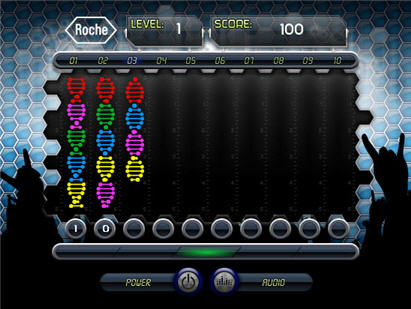You don’t have to be plugged into the new media scene to know that digital games are HOT. According to recent statistics, fully 65 percent of US households play some form of video or computer games. And those involved aren’t just kids: the average game player is 35. 40 percent of game players are women.
The phenomenon doesn’t appear to be slowing down. Momentum for a new breed of social and casual games is picking up speed as game titles migrate to the Web, social media, and smartphones. The Facebook game Farmville has (at last count) more than 30 million active daily users. Top games for the iPhone routinely sell millions of copies, often for low as $1 a copy.
So where does this leave the B2B marketer? Is there a way to leverage the sudden craze for games as part of an integrated campaign? Or are games best suited for the consumer domain?
To learn more, I talked with Mark Talkington, a senior sales executive with Blockdot, a Spear Marketing Group partner and world-renowned digital studio specializing in Interactive Entertainment and Advergaming technologies. Blockdot builds games across Web, mobile, and social platforms, and is considered one of the pioneers in developing games for advertising purposes.
HS: What kind of companies are using games for marketing?
 MT: We build games for both B2C and B2B companies, as well as publishers. Games cross all industries and demographics. We’ve built games for pharmaceutical companies targeting women aged 55+, games for LEGO targeting kids, and games for Microsoft Bing to drive search queries. B2B games are one of our fastest-growing segments. Over the past 10 years, B2B accounted for roughly 10-20 percent of our game development, but we expect that to increase significantly.
MT: We build games for both B2C and B2B companies, as well as publishers. Games cross all industries and demographics. We’ve built games for pharmaceutical companies targeting women aged 55+, games for LEGO targeting kids, and games for Microsoft Bing to drive search queries. B2B games are one of our fastest-growing segments. Over the past 10 years, B2B accounted for roughly 10-20 percent of our game development, but we expect that to increase significantly.
HS: What objectives do marketers typically have in mind when developing games for advertising purposes? Demand generation? Brand awareness? Customer loyalty?
MT: We’ve built games for clients to drive awareness of a new product, highlight a new brand attribute, and drive action through offers like sweepstakes or coupons. A few years ago we built a game and related site for Chevrolet to create awareness for the Cobalt, and to drive traffic for local dealers. The site ended up as one of the top three most visited auto sites that summer.
HS: Can games be a fit for B2B marketers? What are some success stories in B2B?
Absolutely. However, it’s critical to view games as both content and advertising. Our games are not banners and clicks. Games provide more in-depth engagement than other forms of digital advertising. Also, games are best viewed not as a standalone medium but rather as a complementary tactic to your other marketing efforts. All that said, games are a great way to differentiate your product and to break through the clutter.
We’ve developed a very successful game for a major pharmaceutical company marketing a six figure gene splicing machine to a very targeted group of bio-engineers. We’ve built a game for a leading hotel chain to communicate new upgrades at the hotel’s properties to travel agents, along with a call to action to enter a sweepstakes. The possibilities are endless.
* What’s the difference between developing an original game concept vs. “re-skinning” an existing game? When does one make sense vs. another?
Really they’re two sides of the same coin. Most digital games were actually card and board games before they were digital games. A re-skin is where we take an existing game and change the art to fit a client’s brand – for example: envision re-skinning PacMan for M&M’s. A re-skin costs less since you’re not changing the basic game code.
A custom game is where we build new code or perhaps even modify existing code and also create new art.
There’s no simple answer as to when one or the other makes sense. There’s a lot we can accomplish with re-skins, but a custom game can you provide more flexibility.
* What platforms are you developing for primarily today? What do you see the mix being a year from now?
We build Flash AS3 games along with Flash AS3/XHTML apps for Web and Facebook applications. We’re also building games and apps for iPhone/iPad and Android. Going forward, companies and agencies are asking a lot about HTML5. The future is anyone’s guess!
HS: Thanks Mark!
How should B2B companies consider incorporating games into their marketing mix? Could games be a potentially viable form of “content” to weave into lead generation, database marketing, or lead nurturing campaigns? Here are some ideas to consider:
* Build traffic, registrations, and repeat visits for a customer community site
* Build traffic, members, and recommendations for a Facebook fan page
* Increase traffic, “stickiness” and repeat visits for a campaign microsite
* Expand your database and acquire in-profile contacts by targeting a game to a particular demographic (industry, job title, company size)
* For a product launch, develop a game that speaks to the primary attribute/functionality of the new release
Any other suggestions? Feel free to add comments below.

Great article. We build what I’d call “light” games in the B2B space that are tantamount to what I’d call infotainment. Knowledge transfer first, game second.
We know how well our campaigns are doing, but what is the industry standard? How much traffic, how many registrations, or opt-ins?
Our campaigns generate about 20% hit rates, 65% click through rates and 2-5% opt-in rates. Time on site averages around 01:30. What are others getting?